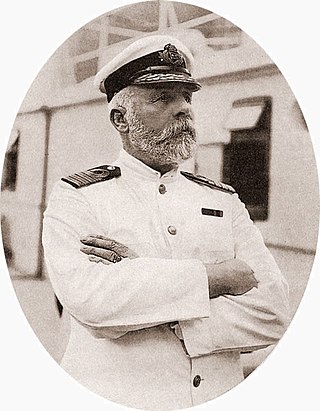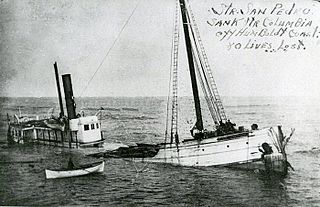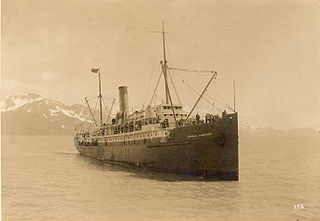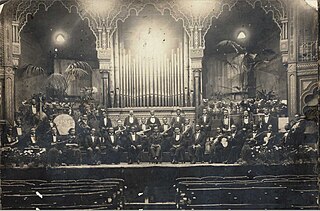Related Research Articles

SSMendi was a British 4,230 GRT passenger steamship that was built in 1905 and, as a troopship, sank after collision with great loss of life in 1917.

The second RMS Laconia was a Cunard ocean liner, built by Swan, Hunter & Wigham Richardson as a successor of the 1911–1917 Laconia. The new ship was launched on 9 April 1921, and made her maiden voyage on 25 May 1922 from Southampton to New York City. At the outbreak of the Second World War she was converted into an armed merchant cruiser, and later a troopship. She was sunk in the South Atlantic Ocean on 12 September 1942 by torpedoes. Like her predecessor, sunk during the First World War, this Laconia was also destroyed by a German submarine. Some estimates of the death toll have suggested that over 1,658 people were killed when the Laconia sank. The U-boat commander Werner Hartenstein then staged a dramatic effort to rescue the passengers and the crew of Laconia, which involved additional German U-boats and became known as the Laconia incident.

USS Queenfish (SS/AGSS-393), a Balao-class submarine, was the first ship of the United States Navy to be named for the queenfish, a small food fish found off the Pacific coast of North America.

SS Schiller was a 3,421-ton German ocean liner, one of the largest vessels of her time. Launched in 1873, she plied her trade across the Atlantic Ocean, carrying passengers between New York City and Hamburg for the German Transatlantic Steam Navigation Line. She became notorious on 7 May 1875, while operating on her normal route, when she hit the Retarrier Ledges in the Isles of Scilly, causing her to sink with the loss of most of her crew and passengers, totaling 335 fatalities.
SS Eubee was a French steam passenger ship built in 1921.

German submarine U-48 was a Type VIIB U-boat of Nazi Germany's Kriegsmarine during World War II, and the most successful that was commissioned. During her two years of active service, U-48 sank 51 ships for a total of 299,477 GRT and 1,060 tons; she also damaged four more for a total of 27,877 GRT over twelve war patrols conducted during the opening stages of the Battle of the Atlantic.

SS Valencia was an iron-hulled passenger steamer built for the Red D Line for service between Venezuela and New York City. She was built in 1882 by William Cramp and Sons, one year after the construction of her sister ship Caracas. She was a 1,598-ton vessel, 252 feet (77 m) in length. In 1897, Valencia was deliberately attacked by the Spanish cruiser Reina Mercedes off Guantanamo Bay, Cuba. The next year, she became a coastal passenger liner on the U.S. West Coast and served periodically in the Spanish–American War as a troopship to the Philippines. Valencia was wrecked off Cape Beale, which is near Clo-oose, on the west coast of Vancouver Island, British Columbia, on 22 January 1906. As her sinking killed 100 people, some classify the wreck of Valencia as the worst maritime disaster in the "Graveyard of the Pacific", a famously treacherous area off the southwest coast of Vancouver Island.

SS Tuscania was a luxury liner of the Anchor Line, a subsidiary of the Cunard Line and named after Tuscania, Italy. In 1918 the ship was torpedoed and sunk by the German U-boat UB-77 while transporting American troops to Europe with the loss of 210 lives.

SS Arctic was a 2,856-ton paddle steamer, one of the Collins Line, which operated a transatlantic passenger and mail steamship service during the 1850s. It was the largest of a fleet of four, built with the aid of U.S. government subsidies to challenge the transatlantic supremacy of the British-backed Cunard Line. During its four-year period of service, the ship was renowned both for its speed and for the luxury of its accommodation.

The SS Mohegan was a steamer which sank off the coast of the Lizard Peninsula, Cornwall, on her second voyage. She hit The Manacles on 14 October 1898 with the loss of 106 out of 197 on board.

The SSCity of Boston was a British iron-hulled single-screw passenger steamship of the Inman Line which disappeared in the North Atlantic Ocean en route from Halifax, Nova Scotia, to Liverpool in January 1870.

SS La Bourgogne was a French ocean liner, which sank in a collision off the coast of Nova Scotia in July 1898, with the loss of 549 lives. At the time this sinking was infamous, because only 13% of the passengers survived, while 48% of the crew did. Before the sinking, in 1886, the ship had set a new record for the fastest Atlantic crossing by a postal steamer.

SS Columbia (1880–1907) was a cargo and passenger steamship that was owned by the Oregon Railway and Navigation Company and later the San Francisco and Portland Steamship Company. Columbia was constructed in 1880 by the John Roach & Sons shipyard in Chester, Pennsylvania for the Oregon Railway and Navigation Company.

"The captain goes down with the ship" is a maritime tradition that a sea captain holds the ultimate responsibility for both the ship and everyone embarked on it, and in an emergency they will devote their time to save those on board or die trying. Although often connected to the sinking of RMS Titanic in 1912 and its captain, Edward Smith, the tradition precedes Titanic by several years. In most instances, captains forgo their own rapid departure of a ship in distress, and concentrate instead on saving other people. It often results in either the death or belated rescue of the captain as the last person on board.

SS San Juan was a passenger steamship owned by the Los Angeles and San Francisco Navigation Company. Previously, she was owned by the Pacific Mail Steamship Company and White Flyer Line. At the age of 47 years, San Juan was involved in a collision with the steel-hulled oil tanker S.C.T. Dodd. Because of her aged iron hull, San Juan was fatally damaged in the collision and sank three minutes later, killing 65 people. The loss of San Juan was strikingly similar to the loss of Columbia.

The steam schooner San Pedro (1899-1920) was the first vessel constructed by John Lindstrom's shipbuilding yard at Aberdeen, Washington in 1899. She was one of many steam schooners constructed by the yard that year, and weighed 456 tons. On October 3, 1905, the San Pedro accompanied the tugboat Pomo when the latter was towing the lumber schooner Santa Barbara, damaged by grounding, to Hunter's Point, California.

RMS Lady Hawkins was a steam turbine ocean liner. She was one of a class of five sister ships popularly known as "Lady Boats" that Cammell Laird of Birkenhead, England built in 1928 and 1929 for the Canadian National Steamship Company. The five vessels were Royal Mail Ships that CN operated from Halifax, Nova Scotia and the Caribbean via Bermuda. In 1942 the German submarine U-66 sank Lady Hawkins in the North Atlantic, killing 251 of the 322 people aboard.

SS Arctic, an American paddle steamer owned by the Collins Line, sank on September 27, 1854, 50 miles (80 km) off the coast of Newfoundland after a collision with SS Vesta, a much smaller French vessel. Passenger and crew lists indicate that there were probably more than 400 on board; of these, only 88 survived, most of whom were members of the crew. All the women and children on board perished.

The SS Admiral Sampson was a U.S.-flagged cargo and passenger steamship that served three owners between 1898 and 1914, when it was rammed by a Canadian passenger liner and sank in Puget Sound. Following its sinking off Point No Point, the Admiral Sampson has become a notable scuba diving destination for advanced recreational divers certified to use rebreathing equipment.

Southern Syncopated Orchestra (SSO), established first in the U.S. as the New York Syncopated Orchestra, was an early jazz group known for bringing Black musicians to the UK. The group was founded by Will Marion Cook. Members of the group included New Orleans clarinetist Sidney Bechet British vocalist Evelyn Dove, and soprano Hattie King Reavis. The SSO toured the UK and Ireland between 1919 and 1921.
References
- 1 2 Rinaldi, Giancarlo (9 October 2021). "SS Rowan sinking: The disaster that rocked jazz music". BBC News Scotland.
- 1 2 "Disaster at sea. Many lives lost". The Times . 9 October 1921. p. 10.
- ↑ Patton, Brian (2007). Irish Sea Shipping. Kettering: Silver Link Publications. pp. 178–84. ISBN 978-1-85794-271-2.
- ↑ "Ship Sinks In Crash, Hit By Two Others; 16 Persons Missing; Rowan of Laird Line in Collision Off Scotland With American Steamer West Camak. Rammed By Rescue Vessel. Disabled Craft Goes Down When Liner Clan Malcolm Strikes Her in Fog. 77 Of 93 Aboard Saved. Members of American 'Syncopated Orchestra' Among Passengers--Its Leader a Hero" . The New York Times . 10 October 1921. p. 1.
- ↑ "History features: London's jazz legends". BBC News London. 15 May 2008 [10 October 2006].
- "SS Rowan [+1921]". Wreck Site. Retrieved 4 June 2013.
55°00′50″N5°18′18″W / 55.014°N 5.305°W